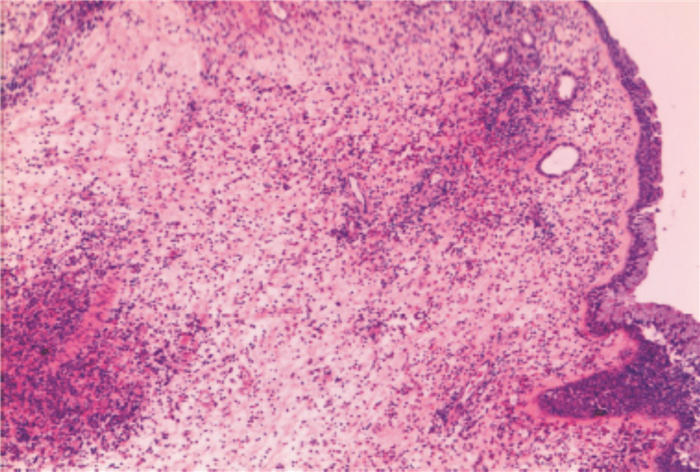Curative effect analysis of radical endoscopic sinus surgery for eosinophilic chronic rhinosinusitis with nasal polyps
-
摘要: 目的 探讨嗜酸粒细胞型慢性鼻窦炎伴鼻息肉(EosCRSwNP)的功能性内镜鼻窦手术(FESS)与根治性内镜鼻窦手术(RESS)的疗效。方法 纳入2020年7月1日—2021年8月1日在河南省人民医院耳鼻咽喉头颈外科诊断为EosCRSwNP的患者44例,嗜酸粒细胞占白细胞的百分比均超过3.05%,将患者按照随机数字表分为FESS组和RESS组,对比两组患者术前、术后1个月、术后3个月、术后6个月及术后1年的视觉模拟评分量表(VAS)、鼻内镜Lund-Kennedy评分和鼻腔鼻窦结局测试22(SNOT-22)的差异。结果 术后1年两组患者各项评分均较术前明显改善,且差异有统计学意义(均P<0.01);两组患者间鼻内镜评分、VAS评分及SNOT-22评分差异均有统计学意义(P=0.01,P=0.03,P=0.03)。RESS组复发率26.09%(6/23),FESS组复发率61.90%(13/21),差异有统计学意义(P=0.04)。结论 RESS和FESS均有助于改善EosCRSwNP患者的鼻部症状,促进嗅觉恢复,但RESS在减少复发、改善患者预后方面更有优势。Abstract: Objective To evaluate the efficacy of functional endoscopic sinus surgery(FESS) and radical endoscopic sinus surgery(RESS) in eosinophilic chronic sinusitis with nasal polyps(EosCRSwNP).Methods A total of 44 patients diagnosed with EosCRSwNP in the Department of Otorhinolaryngology Head and Neck Surgery, Henan Provincial People's Hospital from July 1st, 2020 to August 1st, 2021 were included, the percentage of eosinophils in leukocytes in all patients included was more than 3.05%. The patients were randomly divided into FESS group and RESS group according to random number table. The visual analogue scale (VAS) score, Lund-Kennedy score and sino-nasal outcome test-22 (SNOT-22) were compared between the two groups before operation, 1 month, 3 months, 6 months and 1 year after operation.Results At 1 year after operation, the scores of the two groups were significantly improved compared with those before operation, and the differences were statistically significant (P < 0.01). There were significant differences in nasal endoscopic score, VAS score and SNOT-22 score between the two groups(P=0.01, P=0.03, P=0.03). The recurrence rate of RESS group was 26.09%(6/23) and that of FESS group was 61.90%(13/21), and the difference was statistically significant(P=0.04).Conclusion Both RESS and FESS can improve nasal symptoms and promote olfactory recovery in EosCRSwNP patients, but RESS has more advantages in reducing recurrence and improving the prognosis of patients.
-

-
表 1 FESS组和RESS组患者治疗前临床参数比较
临床参数 FESS组(n=21) RESS(n=23) 统计量 P值 年龄/岁 45(18~73) 43(22~68) t=-0.49 0.63 性别(男/女) 16/5 11/12 χ2=2.63 0.11 外周血嗜酸粒细胞百分比/% 8.04 7.00 Z=-1.13 0.26 外周血IgE/(IU·mL-1) 295.86 281.85 Z=-0.05 0.96 变应性鼻炎/例 7 6 χ2=0.28 0.60 哮喘/例 7 10 χ2=0.48 0.49 鼻内镜评分 4.67 4.39 Z=-0.62 0.54 鼻窦CT评分 19.90 21.48 Z=-1.07 0.29 SNOT-22评分 40.95 42.00 t=-0.40 0.69 VAS评分 6.33 6.96 Z=-1.48 0.14 表 2 FESS组和RESS组患者术后1年与术前各项评分比较
评分 FESS RESS 术前 术后1年 P值 术前 术后1年 P值 鼻内镜评分 4.67 2.19 <0.01 4.39 1.22 <0.01 VAS评分 6.33 2.19 <0.01 6.96 1.35 <0.01 SNOT-22评分 40.95 18.43 <0.01 42.00 12.96 <0.01 表 3 FESS组和RESS组鼻内镜评分比较
组别 术前 术后1个月 术后3个月 术后6个月 术后1年 FESS组 4.67 3.52 3.10 1.33 2.19 RESS组 4.39 4.35 3.17 1.61 1.22 Z -0.62 -2.33 -0.40 -1.92 -2.47 P值 0.54 0.02 0.69 0.06 0.01 表 4 FESS组和RESS组VAS评分比较
组别 术前 术后1个月 术后3个月 术后6个月 术后1年 FESS组 6.33 3.05 2.29 1.86 2.19 RESS组 6.96 3.26 2.48 2.04 1.35 Z -1.48 -0.63 -0.37 -1.23 -2.14 P值 0.14 0.53 0.71 0.22 0.03 表 5 FESS组和RESS组SNOT-22评分比较
组别 术前 术后1个月 术后3个月 术后6个月 术后1年 FESS组 40.95 20.90 20.71 15.38 18.43 RESS组 42.00 22.86 20.30 17.52 12.96 t/Z 0.40 -0.04 -0.06 -1.84 -2.20 P值 0.69 0.97 0.95 0.07 0.03 -
[1] 于蕾, 许彤. 慢性鼻窦炎的内在型分型与治疗反应性的研究进展[J]. 临床耳鼻咽喉头颈外科杂志, 2020, 34(11): 1049-1052. doi: 10.13201/j.issn.2096-7993.2020.11.023 https://lceh.cbpt.cnki.net/WKC/WebPublication/paperDigest.aspx?paperID=160eccd8-cd3a-4fb0-92f5-6a58b4daf593
[2] 王成硕, 娄鸿飞, 孟一帆, 等. 组织嗜酸粒细胞增多对慢性鼻-鼻窦炎伴鼻息肉复发的预测价值研究[J]. 中华耳鼻咽喉头颈外科杂志, 2016, 51(4): 268-272. doi: 10.3760/cma.j.issn.1673-0860.2016.04.005
[3] Ma L, Shi J, Wang K, et al. Clinical characteristics of patients with CRSwNP with intensely high eosinophil level[J]. Laryngoscope Investig Otolaryngol, 2022, 7(2): 316-324. doi: 10.1002/lio2.758
[4] Wang M, Zhou B, Li Y, et al. Radical versus Functional Endoscopic Sinus Surgery for Osteitis in Chronic Rhinosinusitis[J]. ORL J Otorhinolaryngol Relat Spec, 2021, 83(4): 234-241. doi: 10.1159/000513528
[5] Noller M, Fischer JL, Gudis DA, et al. The Draf Ⅲ procedure: A review of indications and techniques[J]. World J Otorhinolaryngol Head Neck Surg, 2022, 8(1): 1-7. doi: 10.1002/wjo2.6
[6] Patel VS, Choby G, Shih LC, et al. Equivalence in outcomes between Draf 2B vs Draf 3 frontal sinusotomy for refractory chronic frontal rhinosinusitis[J]. Int Forum Allergy Rhinol, 2018, 8(1): 25-31. doi: 10.1002/alr.22032
[7] Haddad R, Khoueir N, Smaily H, et al. Safety and Efficacy of the DrafⅡb Procedure: A Systematic Review[J]. Otolaryngol Head Neck Surg, 2021, 165(6): 784-790. doi: 10.1177/01945998211004237
[8] 中华耳鼻咽喉头颈外科杂志编辑委员会鼻科组, 中华医学会耳鼻咽喉头颈外科学分会鼻科学组. 中国慢性鼻窦炎诊断和治疗指南(2018)[J]. 中华耳鼻咽喉头颈外科杂志, 2019, 54(2): 81-100. doi: 10.3760/cma.j.issn.1673-0860.2019.02.001
[9] Tao X, Chen F, Sun Y, et al. Prediction models for postoperative uncontrolled chronic rhinosinusitis in daily practice[J]. Laryngoscope, 2018, 128(12): 2673-2680. doi: 10.1002/lary.27267
[10] Meng Y, Zhang L, Lou H, et al. Predictive value of computed tomography in the recurrence of chronic rhinosinusitis with nasal polyps[J]. Int Forum Allergy Rhinol, 2019, 9(11): 1236-1243. doi: 10.1002/alr.22355
[11] Hwang CS, Park SC, Cho HJ, et al. Eosinophil extracellular trap formation is closely associated with disease severity in chronic rhinosinusitis regardless of nasal polyp status[J]. Sci Rep, 2019, 9(1): 8061. doi: 10.1038/s41598-019-44627-z
[12] Yu L, Jiang Y, Yan B, et al. Predictive value of clinical characteristics in eosinophilic chronic rhinosinusitis with nasal polyps: A cross-sectional study in the Chinese population[J]. Int Forum Allergy Rhinol, 2022, 12(5): 726-734. doi: 10.1002/alr.22901
[13] Kane KJ. The early history and development of functional endoscopic sinus surgery[J]. J Laryngol Otol, 2020, 134(1): 8-13. doi: 10.1017/S0022215119002457
[14] Bhattacharyya N, Villeneuve S, Joish VN, et al. Cost burden and resource utilization in patients with chronic rhinosinusitis and nasal polyps[J]. Laryngoscope, 2019, 129(9): 1969-1975. doi: 10.1002/lary.27852
[15] 史亚男, 季冉, 张桂敏, 等. 轮廓化鼻窦内镜技术对鼻息肉复发的影响[J]. 临床耳鼻咽喉头颈外科杂志, 2021, 35(2): 155-159. https://lceh.cbpt.cnki.net/WKC/WebPublication/paperDigest.aspx?paperID=cafb7f09-9307-4ba0-b21c-31a3a5c021c1
[16] Bhalla V, Sykes KJ, Villwock JA, et al. DrafⅡb with superior septectomy: finding the "middle ground"[J]. Int Forum Allergy Rhinol, 2019, 9(3): 281-285.
[17] Eviatar E, Taha A, Gavriel H. The efficacy of extended DrafⅡb procedure by partial nasal septectomy: long-term follow up[J]. Eur Arch Otorhinolaryngol, 2017, 274(7): 2793-2797. doi: 10.1007/s00405-017-4542-7
[18] Barham HP, Hall CA, Hernandez SC, et al. Impact of Draf Ⅲ, DrafⅡb, and Draf Ⅱa frontal sinus surgery on nasal irrigation distribution[J]. Int Forum Allergy Rhinol, 2020, 10(1): 49-52. doi: 10.1002/alr.22447
[19] Ninan S, Goldrich DY, Liu K, et al. Long Term Olfactory Outcomes Following Frontal Sinus Surgery in Chronic Rhinosinusitis[J]. Laryngoscope, 2021, 131(10): 2173-2178. doi: 10.1002/lary.29513
[20] Zhao R, Chen K, Tang Y. Olfactory changes after endoscopic sinus surgery for chronic rhinosinusitis: A meta-analysis[J]. Clin Otolaryngol, 2021, 46(1): 41-51. doi: 10.1111/coa.13639
[21] Zhang L, Zhang Y, Gao Y, et al. Long-term outcomes of different endoscopic sinus surgery in recurrent chronic rhinosinusitis with nasal polyps and asthma[J]. Rhinology, 2020, 58(2): 126-135.
-





 下载:
下载:
